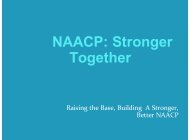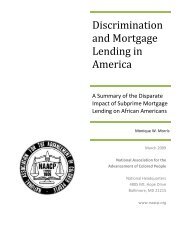TOOLKIT
TOOLKIT
TOOLKIT
You also want an ePaper? Increase the reach of your titles
YUMPU automatically turns print PDFs into web optimized ePapers that Google loves.
Project: Health Disparities<br />
Walk:<br />
Begin educating your group on the role environment plays in our<br />
health. Host a campus or community film screening.<br />
See suggestions below:<br />
An Inconvenient Truth, Al Gore, 2006.<br />
Unnatural Causes, California Newsreel, 2008.<br />
www.unnaturalcauses.org<br />
Living Downstream, The People’s Picture Company,<br />
2010. www.livingdownstream.com<br />
Mann v. Ford, HBO Films, 2011.<br />
Run:<br />
Host a teach-in for your Youth Council/College Chapter and invite<br />
a local official from a local agency, here are some suggestions:<br />
Department of Public Health<br />
Department of Environmental Protection<br />
Local Hospital<br />
Local University that specializes in Health issues<br />
Sprint:<br />
Start a local campaign about the injustices of pollution in your<br />
community or around your campus – see if there is a Superfund<br />
site near you. The action will be determined by your Youth<br />
Council/College Chapter, some suggestions are:<br />
Collect comments regarding the site and post them on the<br />
Facebook wall.<br />
Start a petition, get signatures and submit to the EPA.<br />
Hold a peaceful demonstration highlighting the injustices.<br />
A Superfund site is an uncontrolled or abandoned place where<br />
hazardous waste is located, possibly affecting local ecosystems or<br />
people. To find a Superfund site in your area visit<br />
www.epa.gov/superfund/sites.<br />
Superfund sites are listed on the National Priorities List (NPL)<br />
upon Completion of Hazard Ranking System (HRS) screening,<br />
public solicitation of comments about the proposed site, and after<br />
all comments have been addressed.<br />
MILE MARKER 6:<br />
HEALTH<br />
Resources<br />
American Medical Association:<br />
www.ama-assn.org/ama/pub/physicianresources/public-health/eliminatinghealth-disparities.page<br />
Centers for Disease Control and<br />
Prevention:<br />
www.cdc.gov/healthyyouth/disparities/ind<br />
ex.htm<br />
National Library of Medicine Tox Town:<br />
http://toxtown.nlm.nih.gov/<br />
How to win environmental campaigns:<br />
www.campaignstrategy.org<br />
US Department of Health & Human<br />
Services:<br />
www.hhs.gov/<br />
Reporting<br />
Remember that different forms of<br />
movement are worth specific steps.<br />
Walk = 50 steps<br />
Run = 100 steps<br />
Sprint = 150 steps<br />
Hydration Stations = 25 steps<br />
In order to receive credit for the 10,000<br />
steps all activities must be documented.<br />
To report projects, click on this<br />
link<br />
Fill out the form titled<br />
REPORTING.<br />
Please make sure all the text<br />
boxes are filled out completely.<br />
It is also recommended that activities are<br />
uploaded to the official NAACP pages<br />
listed below with a brief commentary<br />
which includes:<br />
Name of Youth Council/College<br />
Chapter<br />
<br />
<br />
Location<br />
2-4 sentences describing the<br />
activity.<br />
When using social media, use the<br />
hashtags: #10KSteps, #NAACPECJP or<br />
tag NAACP, NAACPConnect,<br />
NAACPECJP.<br />
43 | P a g e








